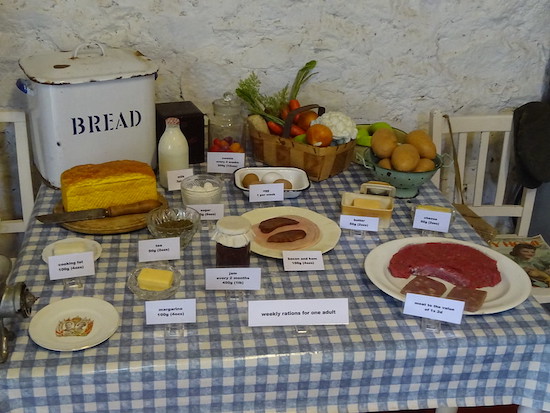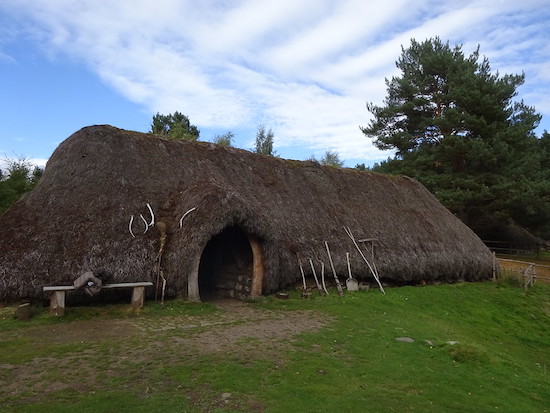I can count the things I have done outside my flat since March – that aren’t a walk around the block where I live – on one hand. Being on the government’s “extremely vulnerable” list means that you get various pieces of conflicting advice and a lot of letters from Matt Hancock, but all of them add up to something like ‘try to avoid being anywhere there are people, especially if it’s indoors’. I have made precisely one attempt to bend this rule – attending a socially distanced art gallery locally one afternoon, and finding the one-way system too much like being in a Post Office queue. I have, accordingly, done only one other cultural thing in the last nine months that does not involve the internet – visiting the Highland Folk Museum, Newtownmore, Scotland, on a holiday by sleeper train in September that has been the only time I have left the M25 since the first lockdown. Part of the genre of ‘open-air museums’, the Highland Folk Museum is easy to be distanced in, because at no point are you ever indoors, unless you choose to wander into, say, a reconstructed Victorian school or a speculative Pictish thatched hut.
The Highland Folk Museum is what many countries would call ‘a Skansen’. The first Skansen was a late 19th century museum in the suburbs of Stockholm, where authentic ‘Nordic’ history could be experienced through buildings which had been taken from villages and small towns across Sweden, dismantled and reassembled in the metropolis, so that those who felt cut off from their roots could get back in touch with them a simple tram ride away. This then became a craze, so that there were by the middle of the century dozens of these around Europe, both east and west (Soviet versions were usually described as ‘Ethnographic Museums’, but ‘Open-Air Museum’ has gradually stuck in English). In these, the effects of modernity and deindustrialisation – with villages emptying and their buildings falling into disuse and obsolescence – were offset by the creation of peculiar unpeopled reservations. What makes a Skansen interesting, and unlike a ‘real’ preserved village, is that the process of selection, decontextualisation and reassembly in an alienated new arrangement is so obvious, the artifice so clear. A Skansen is a village that has never actually existed, and that nobody has ever lived in – though many Skansens combine their galleries of dead buildings with working farms or workshops, in the parallel genre of the ‘living museum’.
There are Skansens scattered around the UK, with some in England, such as the Avoncroft Museum of Historic Buildings in Worcestershire or the Weald and Downland Living Museum in Sussex, though these have a slightly Alan Partridge appearance that you don’t find in the better Skansens, places that are so enduringly eerie that you can’t imagine an owl sanctuary date taking place in them. It’s unsurprising that the best are outside of England altogether; in fact they can be read as assemblages of the places that failed to survive Anglicisation. And while in England a ‘real’ rural life is incredibly distant for the majority of people, in parts of Wales and Scotland it persisted until very recently. St Fagans in the suburbs of Cardiff comes closest to the Swedish effect, given that it is (just about) in the Welsh capital and you can take a bus to it. Everything from an 18th century pigsty to 1940s prefabs to an entire Edwardian working men’s institute from the Valleys can be found there, around a modernist entrance building.
The Highland Folk Museum was the first of its kind on this island. It documents, of course, a way of life which was forcibly dismantled in the clearances of the 18th and 19th century, when agrarian capitalism was brutally imposed upon the defeated side in the various Jacobite wars. Or does it? You’ll actually learn fairly little about any of that in the Folk Museum, though there’s plenty of places where you can around here. Instead, you’ll find an imaginary village in three parts, rolling across hills at the foot of the Cairngorm mountains.
The planner of the museum, which was originally laid out on a different site in nearby Kingussie, was the ethnographer and historian Isabel Frances Grant, who began her collection with a Hebridean Free Church, acquired in 1935. She added a scattering of thatched buildings in the 1940s, and the ethnographic aspect still exists at the fanciful ‘Township’, which with its cramped huts and costumed staff gives some sense of a pre-modern community; a working farm of sorts stands at the other end of the site. But between these is the museum’s centre, which consists of small wooden Post Offices and shops, a school, most of them in wood, most of them from that period that most British nostalgia focuses most on – roughly, the decades from the 1870s to the 1940s, which happens in exactly the sort of prim and tidy new buildings that would have replaced the townships and the thatched cottages.

Perhaps because of the distant presence of the postmodernist 1940s fever-dream that much of British political life has devolved into over the last decade, seeing all of these laid out at the foot of a mountain was a deeply odd experience. In the wooden shack of an interwar primary school (originally from Knockbain, near Inverness), a Navy League Map of the British Empire hangs front and centre, so that pupils at these mean little wooden desks could have their eyes on it at all times; to their right, near the cane, is a series of interwar posters depicting the peoples and trades of said Empire. You could shiver in here as you learned about the distant lands controlled by the crown, and like so many Scots, you could grow up to help administer this vast territory. Each house of the handful taken from the villages of the Highlands and laid out in this impossible microcosmic town clearly belongs to a different social class, which you can read from the height of their ceilings, the size of their rooms, and the books, gee-gaws and framed Bible quotes left around by the curators, an entire social structure in miniature. The biggest house has a wasp’s nest inside, which may or may not be part of the exhibit.
Part of what makes this such a strange place is the way that signs have been laid out as if in a real town; randomly placed between a ‘cottage’, a ‘farmhouse’ and a ‘tailor’, a sign welcomes you to the County of Nairn, 60 miles away; ‘SLOW – MAJOR ROAD AHEAD’ stands on a gravel path to nowhere. One-way systems are indicated to meet social distancing guidelines, but when we visited, tourists were outnumbered by staff. By the time we arrived at the Post Office, the pleasantly odd experience had turned increasingly dreamlike – it was as if random fragments of British life had been torn up and thrown into the air to see where they land on an inhospitable, alien mountainscape, denuded of infrastructure, noise, media, and humans. And at the centre of it all, of course, is the war, the dream-obsession that has invaded all our lives. The Post Office originally stood in Glenlivet, and was acquired by the Folk Museum in 2000. As a chalkboard sign indicates, you can always buy Chisholm’s Linament for 4/3 and a half d here. The time is always 5pm; the year, as indicated by the ink-spattered calendar on the wall, is always 1936, just on the eve of the disaster.
Owen Hatherley is the author of Red Metropolis: Socialism and the Government of London


